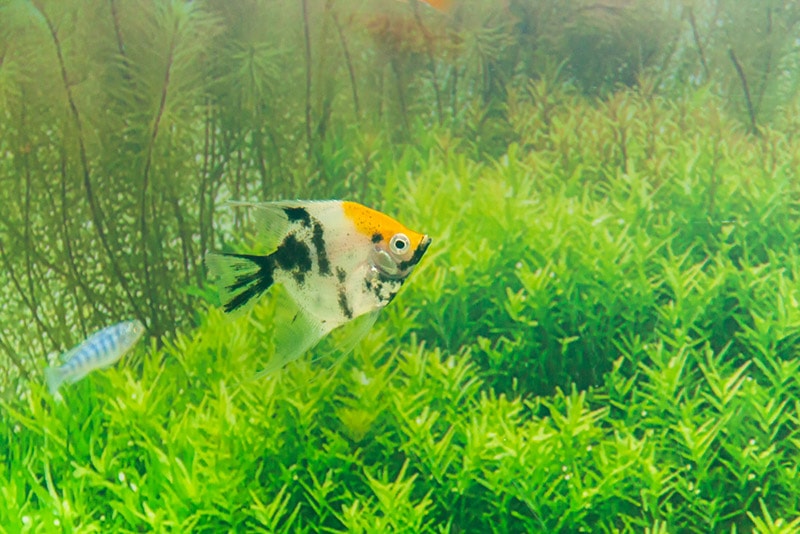How to Get Crystal Clear Aquarium Water – 7 Easy to Follow Steps

Updated on

If you’re struggling to get clear water in your aquarium, you’re not alone. Cloudy aquarium water can be a nuisance and a problem that impacts the health of your fish. If your water is cloudy, you likely aren’t able to enjoy your beautiful fish and the hard work you’ve put into your tank. To get crystal clear water in your aquarium, the first step is to identify why your water is cloudy. That will help you choose a plan of action to get the clearest aquarium water you can dream of.
Causes of Cloudy Water
- Poor filtration: If the filtration in your tank is not adequate for the size of the tank or the number of fish you have then you will likely begin seeing water cloudiness. This cloudiness can be due to waste, food, decaying plants, or a buildup of algae or bacteria.
- Overfeeding: If you are feeding more than your fish and invertebrates are eating, then that extra food has to go somewhere. It may fall under gravel, behind décor, or even into plants. As the food breaks down, it will add cloudiness to the water. Extra food also provides nutrition for bad bacteria, which can increase cloudiness in the water.
- Uncycled tank: When you start a new tank, it takes time for the good bacteria to develop in the tank. Good bacteria help consume toxins in the water and provide a form of biological filtration. While your new tank is cycling, you will likely have a few days to a few weeks of cloudiness in the water while the tank cycle normalizes.
- Overstocking: If your tank is overstocked, it’s at an increased risk of cloudiness due to waste buildup. An overstocked tank will require high filtration and frequent water changes to maintain water quality.
- Algae: Algae blooms will quickly and noticeably cloud the water in your tank. There are multiple colors of algae, but the most common algae types you see will create green cloudiness in your tank.
- Particulates: Particulates in aquariums are often related to the presence of minerals or other compounds in the water. This can be caused by water hardness or new additions to the tank, like clay-based substrate or sand.
The 7 Easy Ways to Get Clear Aquarium Water
1. Decrease light
Too much light encourages algae blooms. If you can decrease the light in your tank without risking killing plants, you will take away part of what is keeping the algae alive.
2. Add plants
The addition of plants will decrease nitrate, nitrites, ammonia, and CO2 in the water. These are all things that algae can use to take over a tank, so if plants are outcompeting the algae for nutrients, your water will be clearer. Plants also release oxygen, improving water quality for your fish.

3. Increase filtration
Ensure the filter pump you have for your tank is of adequate size for the tank. If you have a filter pump that is too small for the size of the tank or the number of fish in the tank, you may have issues with water cloudiness. Over-filtration is better than under-filtration! A 75-gallon filter on a 55-gallon tank is better than a 55-gallon filter on a 75-gallon tank.
4. Encourage good bacteria
Allowing the bio-filter of your tank to grow and stay healthy will decrease cloudiness in your tank. Using filter media that allow for the colonization of good bacteria is your best friend. It’s important to gently rinse your filters in dirty tank water when you do water changes. Rinse just enough to clear out some waste without eliminating the bacteria living in the filter. Another great option for improving good bacteria growth in your tank is the addition of an EcoBio Stone. These volcanic stones are added directly to the tank and have lots of surface area for bacteria colonization.

5. Avoid overfeeding
This is one of the easiest solutions to eliminating water cloudiness! If you stop overfeeding your fish, you will prevent the breakdown of food waste in the tank. Another option to help with this is to get some bottom feeders for your tank that will help clean up the food waste, like snails, shrimp, and bottom-feeding fish.
6. Add activated carbon
Adding activated carbon to your filter is a great option for chemical filtration. The carbon will help bind large particles in the tank, decreasing water cloudiness. You can purchase activated carbon filter inserts that fit the specific model of filter you have or create your own using a product like Marineland Black Diamond Activated Carbon Filter Media. Activated carbon has the added bonus of decreasing unpleasant aquarium scents as well.

7. Use water clarifiers
Water clarifiers, like Aqueon Aquarium Water Clarifier, are a chemical tank additive that will help microparticles in the water bind together into larger particles. This will cause the particles to either get trapped in the filter or drop to the bottom of the tank, making them easier to vacuum up.
In Conclusion
Identifying the cause of your cloudiness can be difficult to determine, but if you keep a close eye on your cleaning, care, and maintenance habits related to your aquarium, this will help you identify the root of the problem. Water cloudiness can be a frustrating problem that may take time to solve. Creating good filtration and an active biome in your aquarium will help improve water clarity regardless of the cause. Once you succeed in getting crystal clear aquarium water, you and your fish will be pleased with the result!
You Might Also Be Interested In:
- How to Clear Murky Water (7 Best Methods)
- 10 Best Aquarium Filters for Large Tanks – Reviews & Top Picks
Featured image credit: Skumer, Shutterstock












